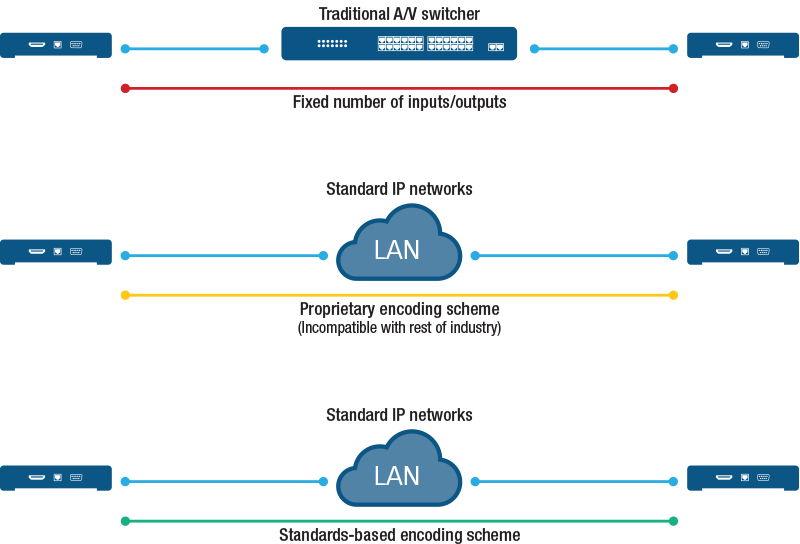
In building internal IT architectures, IT managers traditionally have looked to guidance from standards bodies such as the IETF (Internet Engineering Task Force), which has developed technical and engineering documents designed to make the internet work better. Because the techniques outlined in such standards focus on bandwidth-limited internet connections, an IT infrastructure built in this manner is not equipped to support the increasing number of internal real-time LAN users today who need more.
[Security Breaches, Vulnerabilities & Privacy for IPMX]
Whether working with motion video or the highest fidelity captures of live desktops, these users are not satisfied with seeing inferior images on their screens. In emerging use cases, such as AI-driven analysis in medical imaging and other fields, exceptional real-time images with detail invisible to the human eye are proving indispensable. After all, "visually lossless” compression eliminates the very detail that enables AI to identify patterns that humans cannot.

Fortunately, the bandwidth of LANs is increasing dramatically, both as delivered to the desktop and in multiple network layers above endpoints, while the cost of required network elements is falling. Internet bandwidth is increasing, too, with most countries rolling out 1 Gbps or more to the home.
Thus, for the quickly growing number of real-time video users who expect more and demand better, shared 1 Gbps to the desktop suddenly looks old and inadequate. These users want to exploit the greater speed available today, and to do so over a network architecture designed for streaming and capable of supporting sustained traffic rather than bursty traffic. IT managers must negotiate this trend, as well as the fact that average network traffic is increasing and will continue to do so.
Leveraging Protocols
Because low-bandwidth video streaming remains perfect for many desktop applications, the progressive IT manager needs both an architecture and set of protocols that can support the needs of different users: low-bandwidth streamers and users requiring a better desktop experience of their high-performance content. Facing this challenge, the IT manager can expand their view to include the work of a different set of standards organizations that have been aggregating the needs of a variety of users. Organizations like the Society of Motion Picture and Television Engineers (SMPTE), Advanced Media Workflow Association (AWMA), and Video Services Forum (VSF) have cooperated to create standards for moving media over IP networks, enabling organizations to leverage modern IT protocols and infrastructure more effectively for various applications.
[The Integration Guide to AVoIP 2024]
Supporting design and implementation of networks with consideration of capacity, bandwidth, quality of service, security, and resilience, standards such as SMPTE ST 2110 help IT managers to handle evolving bandwidth requirements and deploy devices with sufficient throughput to handle future demands. Inclusion of the IEEE 1588 standard's Precision Time Protocol (PTP) in the ST 2110 standard allows for synchronization of clocks throughout the network, with sub-microsecond accuracy on a LAN.
PTP has become a powerful tool for ensuring ultra-accurate time distribution within a network, effectively aligning all participating devices to a single time source. As a result, the protocol has become increasingly important in telecommunications, finance, healthcare, industrial automation, and broadcasting—environments that demand high precision and synchronization.

Building on foundational work from ST 2110, the AWMA, VSF, Joint Taskforce of Networked Media (JT-NM), and Alliance for IP Media Solutions (AIMS) defined the new Internet Protocol Media Experience (IPMX) set of open specifications to provide essential interoperability for AV-over-IP. IPMX enables the carriage of compressed and uncompressed video, audio, and data over IP networks, making AVoIP workflows more accessible and easier to use.
As an open standard that fully addresses interoperability crossing network bandwidth, IPMX supports workflows based on different codecs, different compression requirements, and different types of connectivity, joining all those aspects so that organizations don't find themselves backed into a silo where their only choice is to invest further in existing systems. Importantly, it uses PTP if it is there, but if the architecture is not PTP friendly, IPMX works in alternate modes.
Final Specs
In a landmark event for the Pro AV industry, the VSF collaborated with AIMS to undertake a rigorous VSF testing event. Held earlier this year at the Matrox Video facility in Munich, the event engaged multiple manufacturers with IPMX implementations to validate core specifications. Through this event, many of the essential IPMX documents—encompassing critical aspects of audio and video transport, HDCP, control plane requirements, and system timing—were taken from draft to finalized specifications.
[SCN Hall of Fame 2024: Lorne Trottier]
This transition started at the top with uncompressed video, and it has been proceeding down through lightly compressed on a 10 GbE network, moderately compressed video on a 1 GbE network, and toward highly compressed formats, such as H.264, NDI, and all universal communications. Across all these formats, IT managers working with IPMX can follow the standards and know that their systems will be compatible and give them future options.
The elevation of key documents from the VSF is accelerating adoption by both manufacturers and end users. As IPMX is implemented by an increasing number of manufacturers, a robust, open AVoIP ecosystem will arise. Within this ecosystem, organizations are free from the limitations of working with specific chips or intellectual property. Instead, they have a point of reference that provides guidance for any decisions that need to be made in building out AVoIP. Working with a widely accepted open standard, IT managers can design against that reference and lay out a future direction for technical growth or evolution.
While Matrox Video has been a major driver of IPMX along with other AIMS members, the strength of IPMX comes from the fact that it originates in the standards world. No single manufacturer dominates the shape or scope of the standard. As a result, IPMX provides a standards-based approach that accommodates a broad array of users working with motion video or high-fidelity captures of live desktops.
Earlier this year, numerous implementations, both in hardware and software, showcased accelerated adoption of IPMX. One notable advance has been the wholesale adoption of IPMX by the fast-growing LED sector, where panels increasingly must support the highest video quality (uncompressed). And now, leading LED wall controller vendors have committed to providing IPMX support. This is a significant development for IPMX, as the standards and specifications continue to drive the future of video transport over IP.
[IPMX Unpacked: The Key Documents Shaping the Future of AV-over-IP]
IPMX is emerging as a comprehensive solution for handling AVoIP, and its evolution promises to bring value to organizations that need to accommodate increasing demand for real-time, high-performance images and video, as well as rising traffic and increasing pressure on network infrastructure. Ongoing work addresses aspects such as interoperable USB extension, profiles, detailed testing requirements, and more. While IPMX is still on its way to becoming a fully realized open standard, it already offers IT managers and their organizations a clear, well-designed, and scalable framework for high-quality, low-latency, and affordable video and audio transport over an IP network—as well as normal corporate IT traffic.







